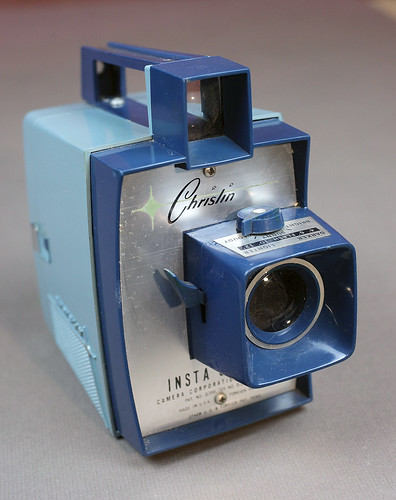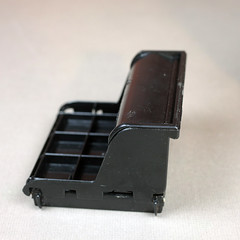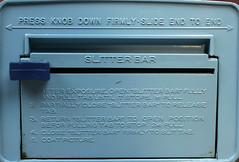Chrislin

|
| Chrislin image by Frank Reiser (Image rights) |
The Chrislin is an instant film camera created by Camera Corporation of America (CCoA), Hicksville, NY, as a competitor to Polaroid’s profitable “picture in a minute” market. Properly it is identified as the Chrislin Insta-Camera Model 100 but since it is the only model ever produced its simple name suffices to identify the camera. The market price for the two-toned blue molded plastic camera was about $20.00 when released in 1965 - the same price as a Polaroid Swinger.
The Chrislin’s exterior design is basically that of a box camera with a “see-through” molded handle doubling as a viewfinder. The camera’s four exposure settings range from what is listed as “bright” through “dim light“. A lever mounted above the lens housing switches internal field stops into position behind the camera’s fixed focus lens to adjust for the settings. A plastic coated metal lever jutting from the lens housing’s right side activates the camera’s self-cocking shutter. The shutter speed sounds like a standard box camera’s approximate 1/50 second. No information is found on the camera regarding the lens’ speed or focal length. On the left side of the camera are two holes for mounting a custom flash unit included with the camera.
The Chrislin’s back swings open by pressing a chrome-plated release button on the rear right side of the camera and allows for the dropping in of a large plastic cassette containing the film and developing chemistry. The film cartridge is “L” shaped and slides in alongside an internal fixed diagonal mirror. The mirror is first sided and marked boldly “CAUTION – MIRROR DO NOT HANDLE.” That is

|
| Warning to protect first-surface mirror image by Frank Reiser (Image rights) |
because it is a first-surface mirror having its aluminized surface on top of the glass surface, not behind it, so touching could leave a residue that will etch its surface. It is also easily scratched. Since the light path of a first-surface mirror does not travel through the mirror’s glass to be reflected as it does in a conventional mirror it does not produce a “ghost reflection” off the uncoated top glass surface. This yields a sharper image. The angled mirror is needed to correct the reversal of a projected image from the taking lens so a correctly oriented image on the final positive picture results. The mirror directs the taking lens’s image to the paten of the film cassette. The film cassette it’s “L” shape is to create a flat film plane over which the film is drawn as the camera operator pulls a paper tab advancing the film between exposures.

|
| Chrislin's Instant Film Cartrige
the film pull-through slot. |
To load the film, a proprietary film cassette available mail-order from CCoA , is dropped into the camera from the rear and the film’s paper tab and is fed through an opening in the camera back. The opening, protected by a door when not being used, contains a sliding knife to sever individual photographs as they are pulled from the camera. Two small pegs on the left and right side of the film opening will hook holes in the film to stop its withdrawal at the proper point - if the film is pulled properly. The only film available for the Chrislin was named “Spectrapan Type 100," a black and white film probably having an ASA of 100 but that is not confirmed anywhere on the pack”aging. The ASA of Polaroid’s black and white film at that time was 640.

|
| The operating instructions are embossed into the
camera back's door covering the film's pull-through slot. |
According to Jason Schneider, Christlin’s instant development method was created originally by Agfa. After Agfa's patent expired CCoA picked up the process and adapted it to the Chrislin. Schneider further claims that as a result of the Chrislin’s unpopularity, which lead to the company’s rapid crash into bankruptcy, only a few hundred Chrislins were manufactured making the strange beast a rare camera.
Link/Source
- Chrislin Model 100 at Novacon
- Schneider, Jason. Jason Schneider on Camera Collecting, Book Three. Des Moines, Iowa: Wallace-Homestead, 1978. ISBN 0-87069-142-2. Pp.61-62